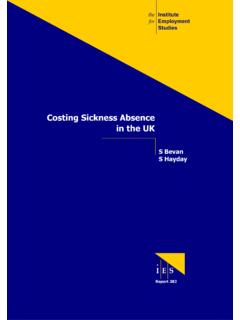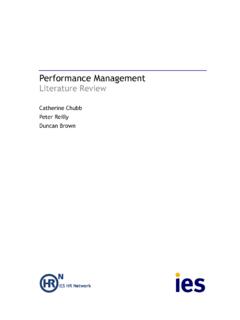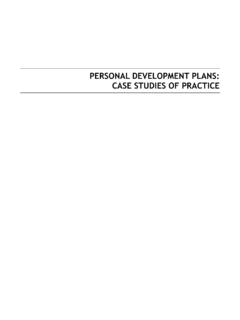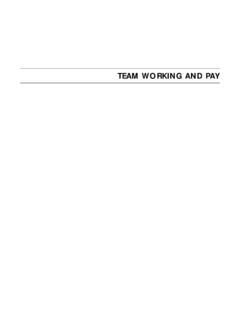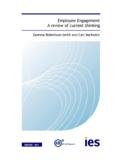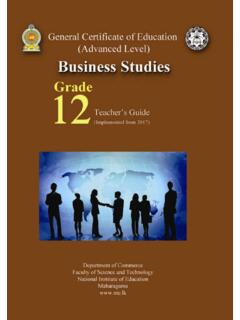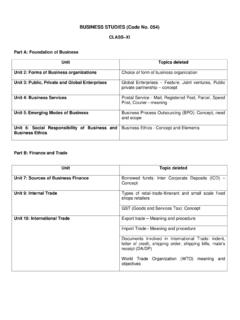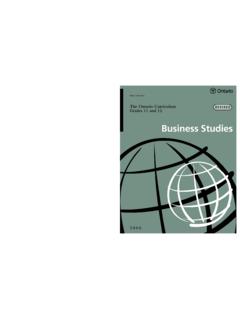Transcription of Workforce planning: a literature review
1 Workforce planning : a literature reviewAlice SinclairProduced by:INSTITUTE FOR EMPLOYMENT STUDIESM antell BuildingFalmerBrighton BN1 9 RFUKTel. + 44 (0) 1273 686751 Fax + 44 (0) 1273 690430 2004 Institute for Employment StudiesNo part of this publication may be reproduced or used in any form by any means graphic,electronic or mechanical including photocopying, recording, taping or information storage orretrieval systems without prior permission in writing from the Institute for Institute for Employment studies is an independent, apolitical, international centre ofresearch and consultancy in human resource issues. It works closely with employers in themanufacturing, service and public sectors, government departments, agencies, and professionaland employee bodies. For 35 years the Institute has been a focus of knowledge and practicalexperience in employment and training policy, the operation of labour markets and humanresource planning and development.
2 IES is a not-for-profit organisation which has over 60multidisciplinary staff and international associates. IES expertise is available to all organisationsthrough research, consultancy, publications and the aims to help bring about sustainable improvements in employment policy and humanresource management. IES achieves this by increasing the understanding and improving thepractice of key decision makers in policy bodies and employing is Workforce planning ?1 History of Workforce Planning2 Context of Workforce Planning4 Why do Workforce planning ?5 Models and Techniques of Workforce Planning7 Who is Doing Workforce planning ?9 Does Workforce planning Work?10 Conclusion17 Bibliography18ivvSummaryWhilst Workforce planning has been around for a number ofyears, there has been a recent resurgence of interest in this HRpractice as organisations have begun to realise that the need forplanning is greater than ever.
3 The current business climate ofintense competition and increasing speed of delivery means thatorganisations need to plan ahead in order to survive. Thefluctuating economy means that they need to be prepared forpossible downturns as well as upturns. In addition, changingdemography, in particular the ageing of the Workforce , means thatorganisations need to make efforts to avert an impending loss ofskills as a large portion of the Workforce retires. Workforce planning is not exclusive to the private sector. Thepublic sector faces a number of the same pressures, in addition toextra pressures of staff shortages and demands to modernisebusiness. Both in the US and here in the UK governmentinitiatives are requiring local authorities to demonstrate workforceplanning capability and action.
4 The benefits of conducting Workforce planning are many andvaried. Essentially it helps organisations to get the right people inthe right job at the right time . It allows for a more effective andefficient use of workers and for organisations to prepare forrestructuring, reducing or expanding their workforces In additionto the practical benefits, the process of Workforce planning aidsorganisations by providing overarching objectives which integratethe various units and allow employees space and time to thinkabout common goals for the number of models and techniques are available to helporganisations conduct Workforce planning . What is appropriatefor an organisation to use depends on how easily it can beimplemented and the ease with which it can be tailored to thesituation at hand.
5 Most models are broadly alike but there aresome specific models which focus on particular organisations ortypes of work or on short-term logistical planning . There are alsosophisticated software packages available. However, mostorganisations do not need a complicated approach and it is oftenbetter to take the simplest route than to try to do too much. Workforce planning is long term and takes place in the context ofmany other internal and external influences so it is not easy to saywhether or not it works. However, some HR researchers estimatethat the majority of Workforce planning fails and describe anumber of issues from which organisations could learn:z It is important that Workforce planning is not seen as beingable to predict the future or organisations will end updisappointed.
6 Rather, it should be seen as setting the longer-viterm context for business issues and providing a decision filterthrough which other plans can pass. z HR staff often find Workforce planning challenging. It presentsa strain on their resources and is difficult to fit into thetraditional HR role. HR professionals may also lack anunderstanding of business issues which would help increating Workforce plans and in selling them to theircolleagues. z The approach of Workforce planning is often try to set a bull s eye target covering the entireorganisation to be reached over a fixed time-period,sometimes spanning several years. However, fluctuations(both internal to the organisation and external) mean that theyrarely follow straight-line paths.
7 To be effective, workforceplanning needs to be flexible, ongoing and sensitive to thedifferent needs of units. It should not stand alone but shouldbe integrated with business plans in a symbiotic relationshipwhere they both react to and inform each other. z Finally, Workforce planning should not be too ambitious in itsobjectives. It cannot be expected to even out the peaks andtroughs of the business world. Nonetheless it is an importantpractice. It is much better to develop a clear understanding ofthe present situation, consider key future issues and managethe interplay between the two than to leave things entirely tochance. Workforce planning : a literature review1 IntroductionWe are currently facing the golden era of Workforce planning (Sullivan, 2002a).
8 Whilst some organisations have beenconducting Workforce planning since the 1960s, there has been aconsiderable resurgence of interest in the last decade as it hasrisen to become one of the hottest topics on the planet (Sullivan,2002a). Despite the recent enthusiasm, the implementation ofworkforce planning continues to present difficulties topractitioners and it has been described as one of today s greatestbusiness challenges (Laabs, 1996).This report draws on academic literature , practitioner literatureand case studies to understand the issues surrounding workforceplanning. No attempt is made to detail the specific techniques andmodels or to describe how they should be applied (for guidanceon the operational features of the practice please refer to theEmployer Organisation s Workforce planning : Guidance for LocalAuthorities ).
9 Instead, the report is concerned about understandingthe context of Workforce planning its history, who uses it andwhy. In addition to highlighting the benefits that workforceplanning can bring to organisations, it will address some of thedifficulties that practitioners may expect to experience. At the outset, it is important to note that the academic literatureon this area is scarce. The majority of published information isbased on anecdotal evidence and not robust research we cannot profess to an exhaustive search, it appears thatthe renewed interest amongst practitioners is yet to be matched byacademics. Nonetheless, this day-to-day experience of practitionersprovides a valid insight from which we can learn. Although the intended audience for the report is local authoritieswithin the UK, the literature is drawn from a range of public andprivate sector organisations, both in the UK and abroad.
10 Somemay question the relevance of a large multinational corporation sexperience to the current context. However, it is important to notethat different organisations face a number of common externalpressures, especially those relating to the changes in workforcedemography. In addition, it would be foolhardy to negate thelessons learned from the private sector, which typically has amore substantial history of using Workforce planning techniques. What is Workforce planning ?Before looking at the literature it would seem helpful to clarifywhat is meant by Workforce planning and how it can bedistinguished from other concepts. A number of definitionsabound. Perhaps the most simple and most commonly useddefinition describes Workforce planning as:2004 Institute for Employment Studies2 Getting the right number of people with the right competencies in theright jobs at the right more comprehensive definition, which highlights some of theprocedural issues involved, defines it as:A process in which an organisation attempts to estimate the demand forlabour and evaluate the size, nature and sources of supply which will berequired to meet that demand.
